
Lieutenant Narwhal ! You must restore the Cosmic Balance !
Maybe a shaman or a guru would be best suited such a task ?
No, no, no, we mean the Cosmic Balance of Power! We need you to shoot people in space !
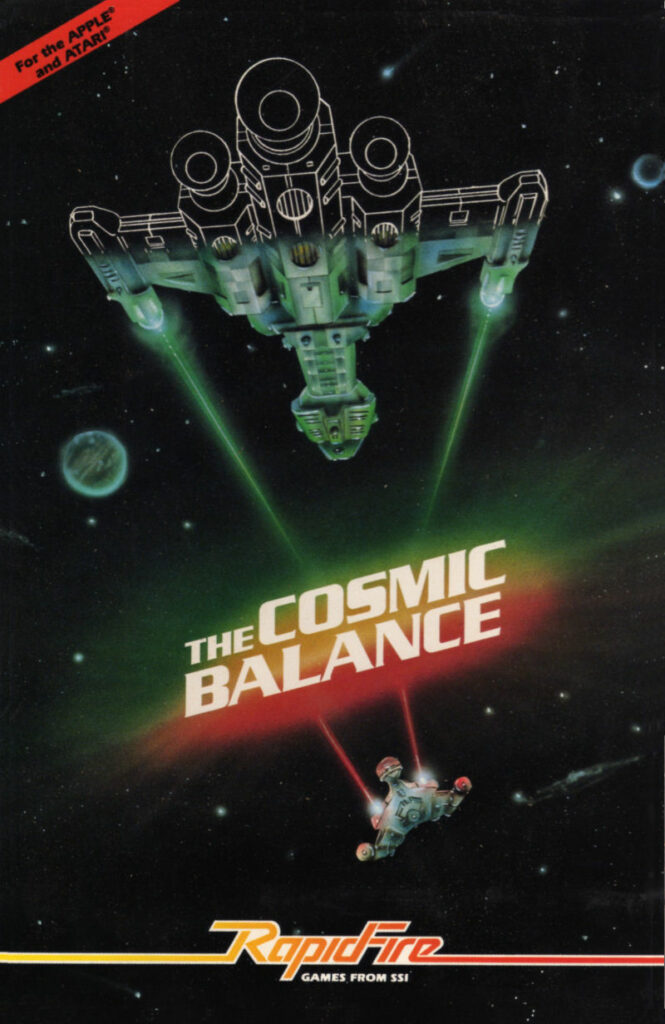
Paul Murray, the only full-time designer/developer SSI had in 1982, had started his video game career with the Warp Factor in 1981. It was a major success, unlike Murray’s later historical games (Napoleon’s Campaigns and Road to Gettysburg). Hence Joel Billings and Paul Murray decided to return to space with what was, in everything but name, a sequel to Warp Factor : the Cosmic Balance.
The Cosmic Balance fixes one of the weaknesses of the Warp Factor : the lack of playable ship combinations. If you recall, there were 12 ships available in the Warp Factor (all of them derivatives of well-known licences), but the difference in size and power of the various ships was such that only a few combinations were, in my opinion, really viable ; after all Tie Fighters can’t really compete against the USS Enterprise. The Cosmic Balance solves this problem by allowing you to create your own ships. Actually, this is an understatement : the Cosmic Balance forces you to create your own ships.
Note that this AAR will be fairly short, as the game is very similar to the Warp Factor, which I previously discussed in my AAR and Review. I will mostly focus on the differences here.
The Cosmic Balance offers many more scenarios than the Warp Factor :
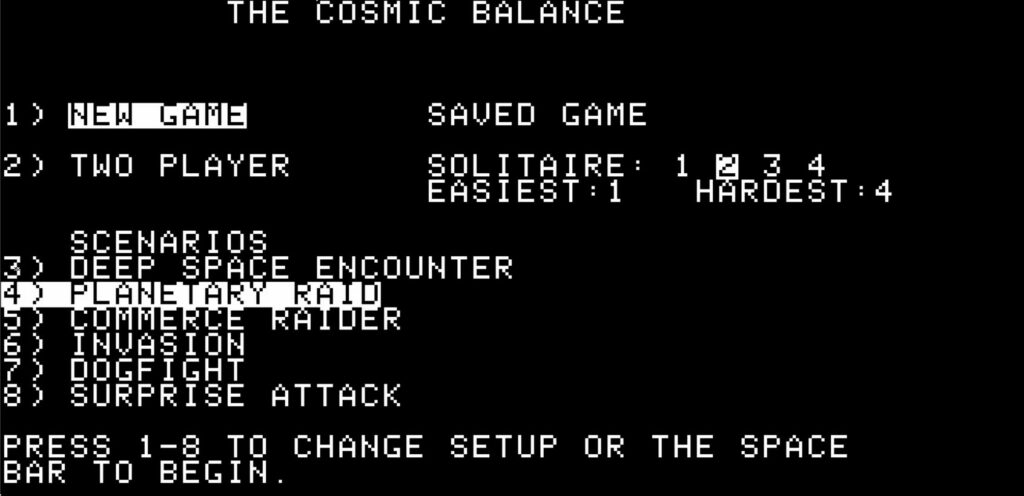
I choose Planetary Raid, in which an Alliance dreadnought must bombard <checks screenshot> the Brotherhood’s planet of Dirgos while fending off 3 Brotherhood destroyers.

After this, it is time to design my ship !
The shipbuilder first asks the player which size you want your ship to be (from puny “corvettes” to massive “dreadnoughts”) but in this case the scenario leaves me no choice : I have a dreadnought. It then asks the player to choose a “technology level”, which despite its fancy name mostly determines how much stuff you can cram in your ship. Of course, high-tech ships are also worth more victory points, so don’t lose them.

The class of my ship (battleship) and the technology level I choose (4 out of 6) give my ship a starting mass of 16, 40 crew members (not displayed) fitting in 20 hull spaces, and 188 spaces left to allocate.
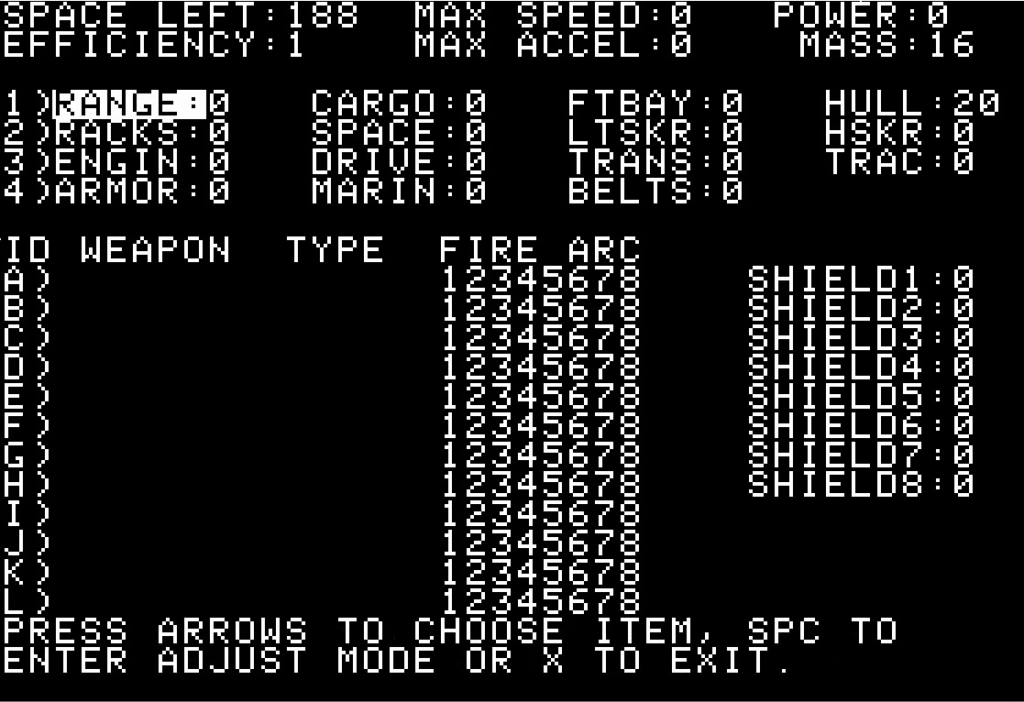
As I will be the one attacking, the scenario requires that I allocate 22 spaces to increase my “range” to 2, in other words, my capacity to jump from systems to systems at the (inexistent) strategic level. Therefore, my real available space is 162.
I design my ship with two goals in mind :
- I want to use weapons and systems that were not present in The Warp Factor, or that I least I did not showcase much,
- My mission is to damage as much as possible a planet in only 10 turns, so I need to quickly get rid of the 3 destroyers that could come from any direction AND have something to pummel the planet,
Given this, here are my weapons :
- The coolest new weapon is the fighter bay, so I’ll have two, garçon. It will be perfect to neutralize 2 of the 3 destroyers, even though these bays take a lot of space (52, so I am down to 110 available spaces),
- For the last destroyer, and to maybe finish the fighters’ job, I also mount 4 missile racks, allowing me to equip 8 light seekers, and 4 heavy seekers,
- Once I have drilled an hole in the destroyer energy shields with either the fighters or the missiles, I will beam marines to take control of them, so I pick-up 25 marines, requiring me to increase my hull (=crew quarter) by 25. I also take 5 teleporters to beam them 10 by 10 on hostile ships. But you can already forget about them, I will never have the opportunity to use them,
- Finally, for the planet itself, I will bring siege phasers exclusively mounted at the front of my ship (mounts 1 and 8). The arc of fire will be pretty narrow, but I don’t think the planet can outmanoeuver me,

I don’t need much speed – I don’t expect the planet running away either – so I bring only 6 drives for a max speed of 12 megaklicks by turn. From this I calculate how much energy I need (around 20) but it’s cheap so I take 4 engines.
Finally, I allocate whatever I have left to shields all around and to “belt defence” (basically Close-in Weapon System [CIWS] to stop missiles and such).
And my ship is ready. I call it the Hornet, because of all the fighters it carries.
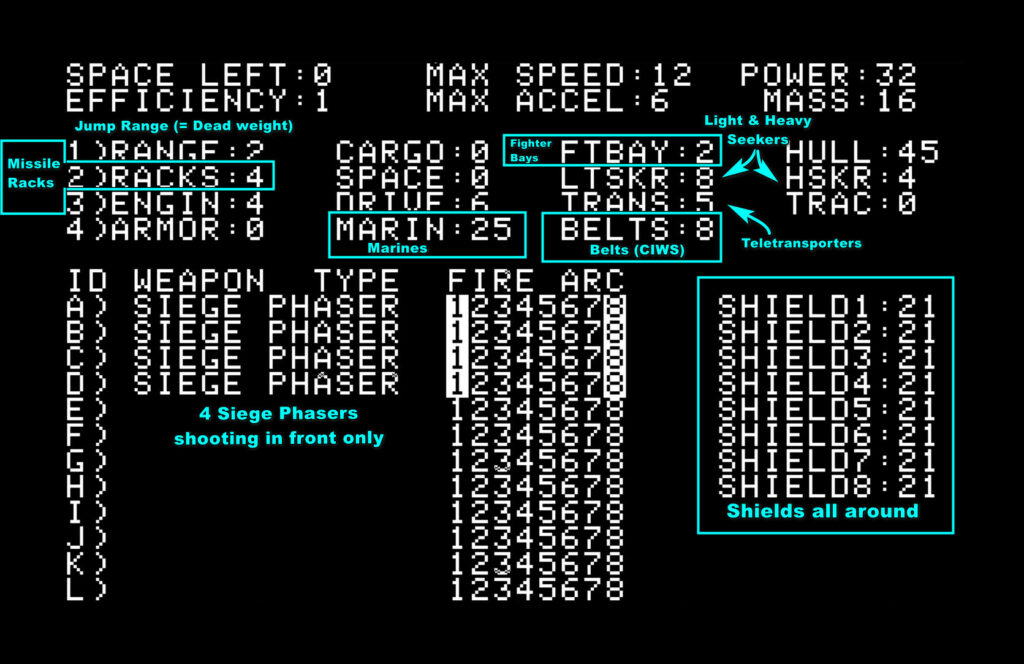
The game then asks me to build the AI’s ships ! I could create ships with no armour, only empty cargo, but it would not be very interesting, would it ? Long story short, I create gunships with only forward shooting weapons, a reinforced front shield and twice as fast as the Hornet. The destroyers are called the Redoutable, the Inflexible and the Foudroyant.
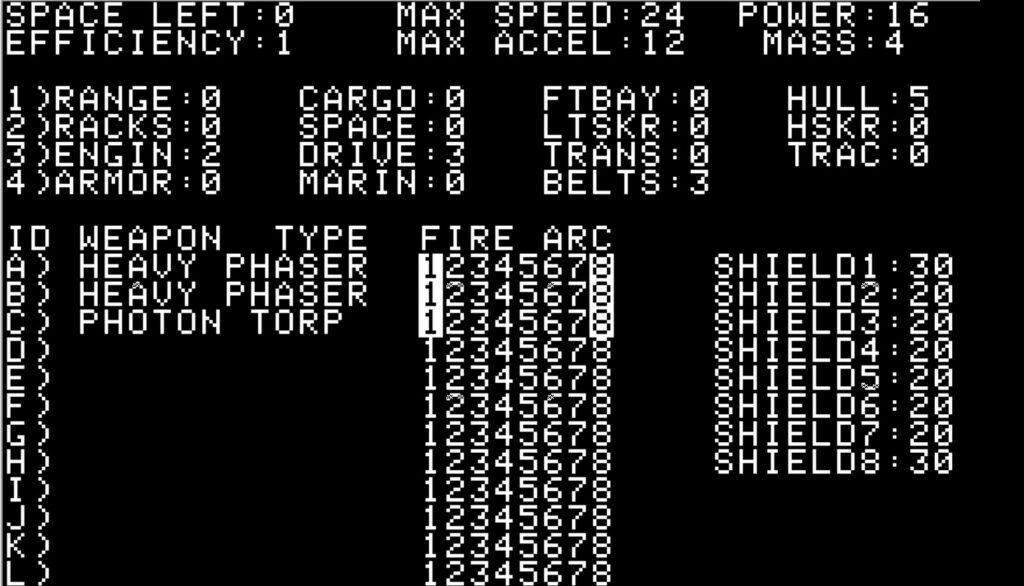
And the battle starts ! Both forces start at roughly 40 megaklicks from each other, my ship at the bottom left, their ships at the top right.
Incidentally, this is exactly the same starting position as any scenario in the Warp Factor.

The first turn is spent accelerating, shooting phasers at inefficient range and on my side, sending a seeker at the Inflexible and a first fighter swarm at the Redoutable. The destroyers break formation the second turn, as I launch my second fighter swarm and another seeker, both at the Foudroyant :

The following turn, it is only me and the Redoutable for a frontal pass. I send a seeker that misses, but four siege phasers at close range deal 42 damage to its frontal shield, which is destroyed. The fighter swarm deals additional damage…
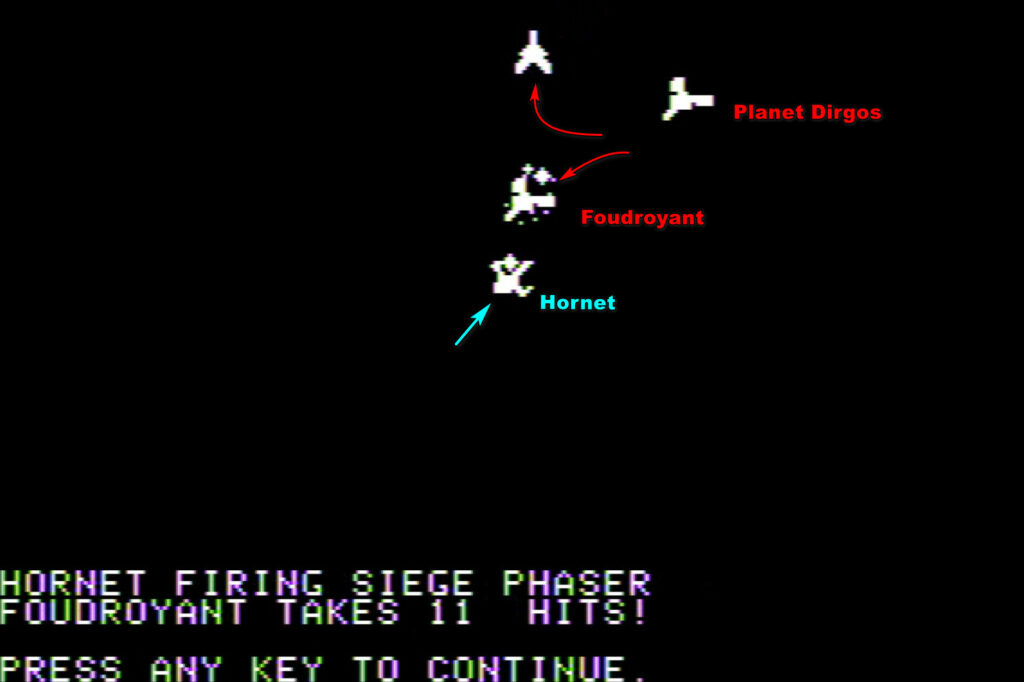
… and the swarm finishes the Foudroyant off the following turn.
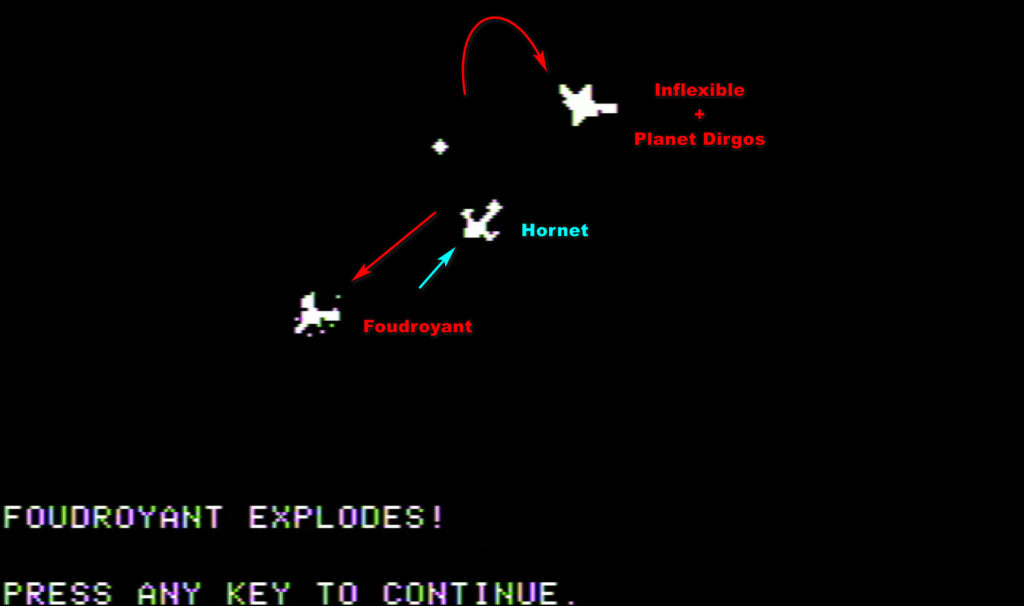
The Redoutable is far away, trying to survive another fighter swarm. The Foudroyant is foudroying no more, so now only the Inflexible is in a position to defend Planet Dirgos. I have 6 turns left to deal as much damage as possible, so I focus my siege phaser fire at the planet, while sending more missiles at the Inflexible.
The heavy front shield of the Inflexible absorbs my seeker, while the Inflexible‘s phasers and torpedoes go through my shield.
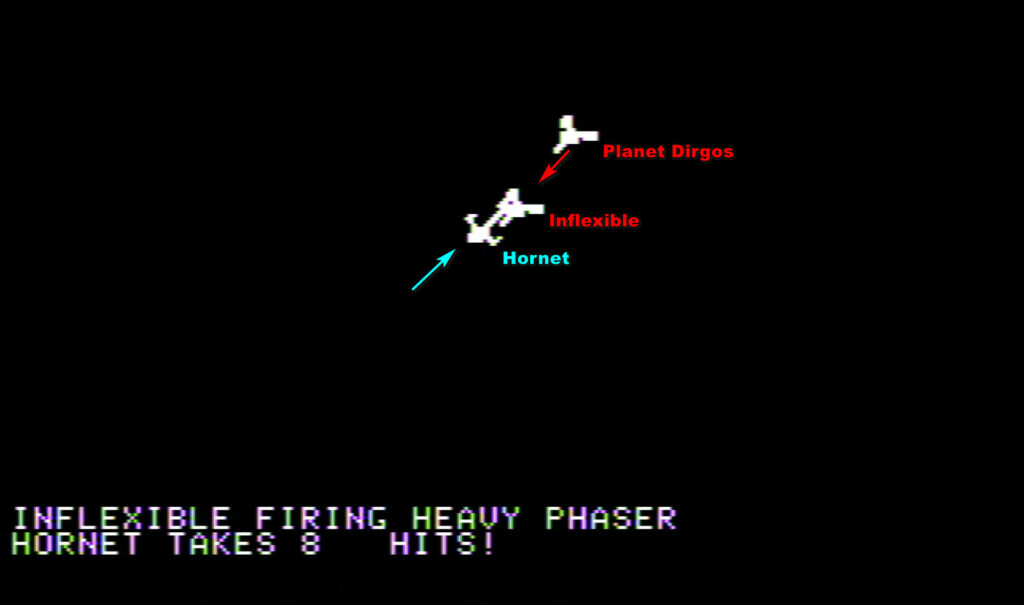
I approached this mission as a juggernaut, “turning is for wimps“, so I don’t try to manoeuver at all. Instead, I slow down to shoot Planet Dirgos at point-blank range.
While the Redoutable is still nowhere in sight (I suspect its ability to turn was destroyed very early on), I still pummel the planet. Meanwhile, the Inflexible comes all guns ablaze. My side shield cannot repel firepower of that magnitude.
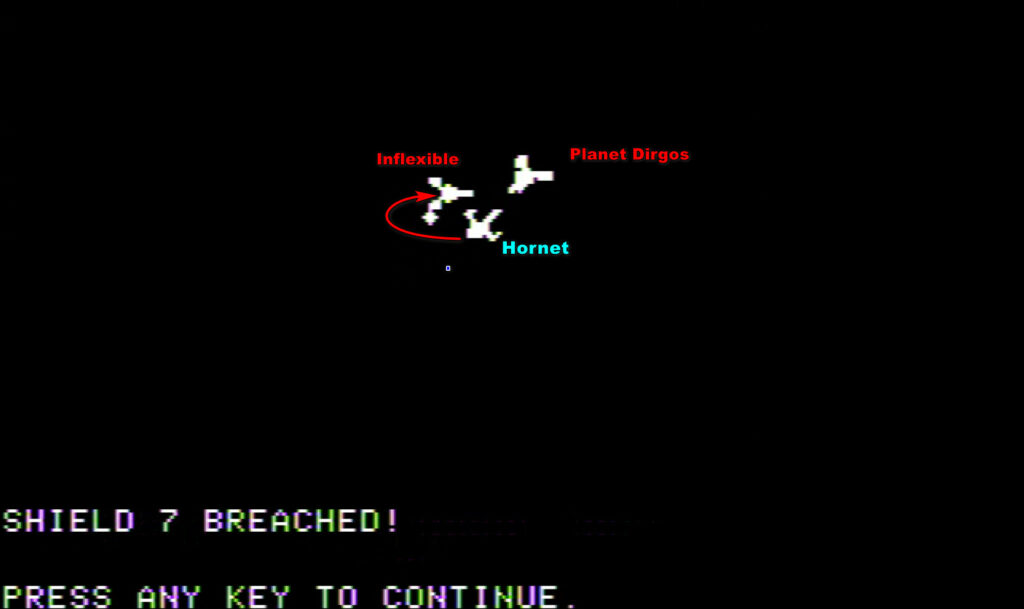
This forces me to use another new feature of the Cosmic Balance.
- In the Warp Factor, a shield stopped all damage, until it was totally destroyed. As long as it was not totally destroyed, it was very easy to “reinforce” for one turn, as there was no limit to how much energy you could allocate to such reinforcements. The gameplay was therefore to attack enemy ships from an unexpected angle (so the shield would not be reinforced) ; this made battles very long,
- In the Cosmic Balance, shields absorb as much damage as their value (eg a shield of power 10 would let 4 damage go through if an attack hit for 14). Whatever damage is absorbed erodes either the current value of the shield or its maximum value, depending on the weapon.
Let’s take the status of the Hornet‘s shields at this point :
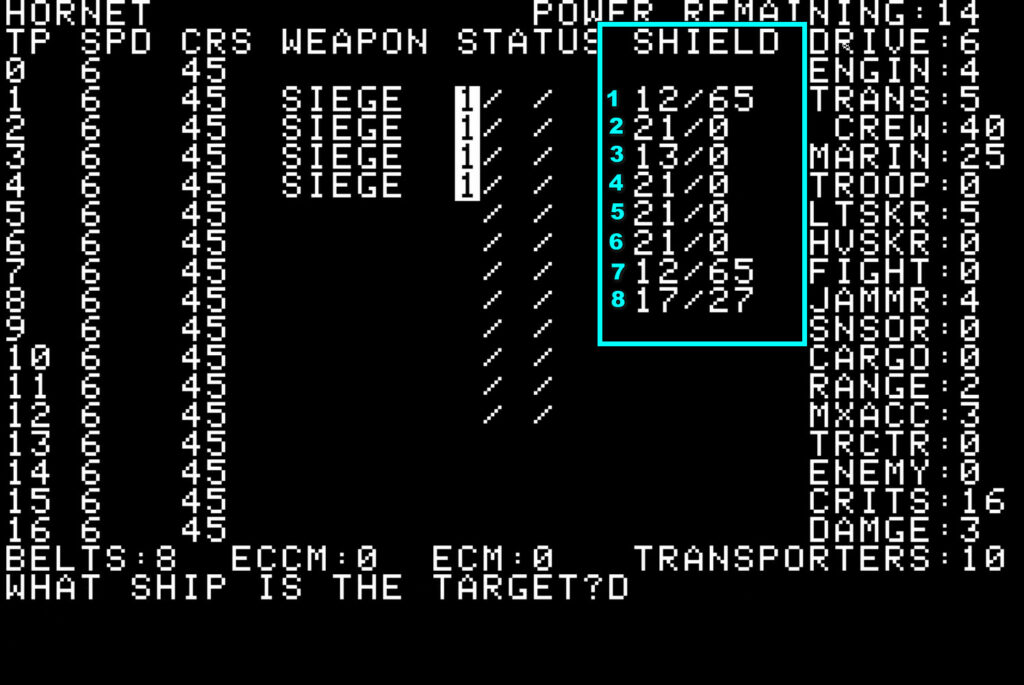
My shield #3 received a photon torpedo the previous turn. Photon torpedoes drain shields forever, so its new maximum value is 13.
The rest of the time, I received phaser damage only, on my shields #1 (frontal-right) #8 (frontal left) and #7 (left frontal). Their current value is respectively 12, 17 and 12. I can restore them fully to 21 by investing respectively 65, 27 and 65 power (8 power = 1 shield value). Keep in mind that my ship generates 32 power by turn, and I need some of that to use my phasers and other systems, so I am not going to recharge my shields in the 5 turns I have left.
On the other hand, I can transfer power from one shield to another (at a 2:1 ratio). With the Inflexible on my left, it is exactly what I do…
….just in time, because the Inflexible shoots everything it has once again, before increasing its distance from the Hornet.
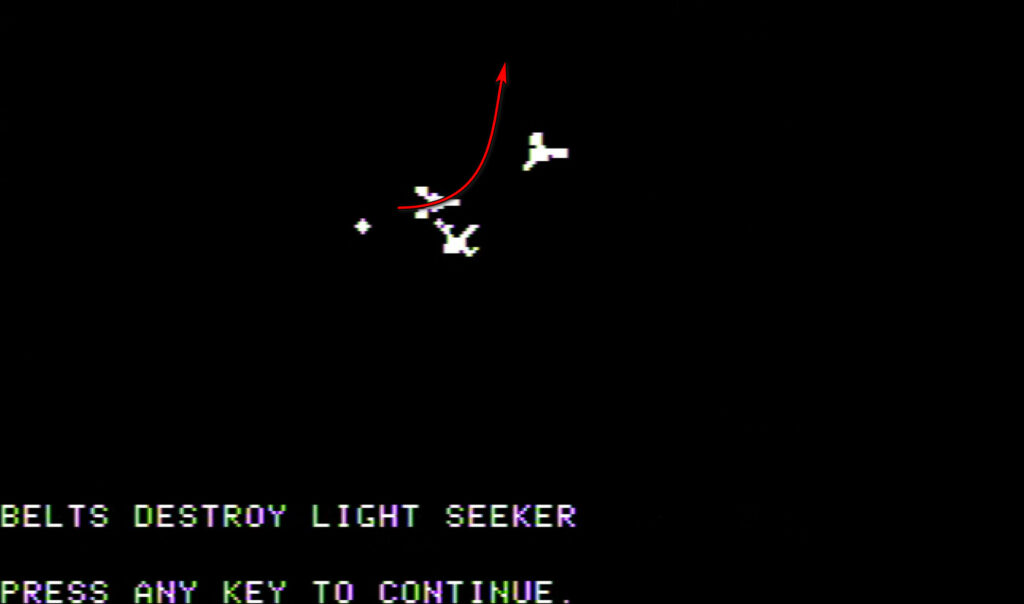
This time, I received significant damage, in particular losing half my phaser-power :
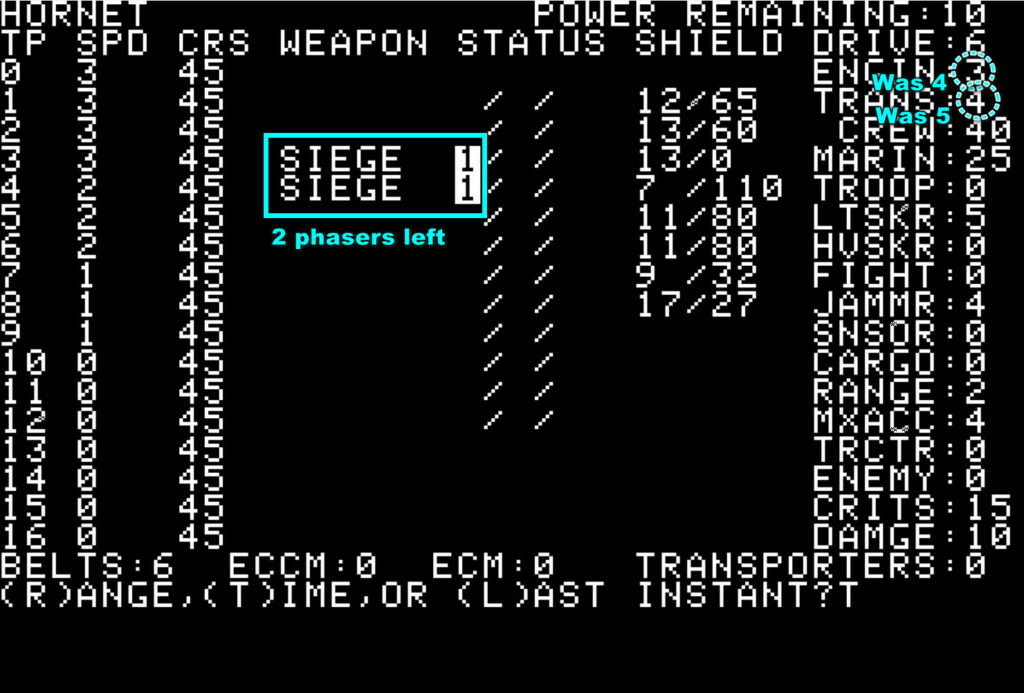
Meanwhile :

That’s the end of the battle, I get one more round to shoot at the planet with my remaining phasers, and then the game forces me to jump out. Time to count the points :

The way the VP system works in the Cosmic Balance is that each surviving ship gives its side its value victory points, minus the damage. As an exception to this rule, in this scenario, the destroyers only give one-quarter of their points to the AI – they are supposed to be expandable. But there is a bug in the point calculation : the game says I won, but only because it divided Dirgos’s value by 4 as if it had been a destroyer. Dirgos was intact when I jumped out of the battlefield, and as such was worth really 180 points.
Just like in The Warp Factor, you can check enemy ships at the end of a battle, so here is Dirgos :
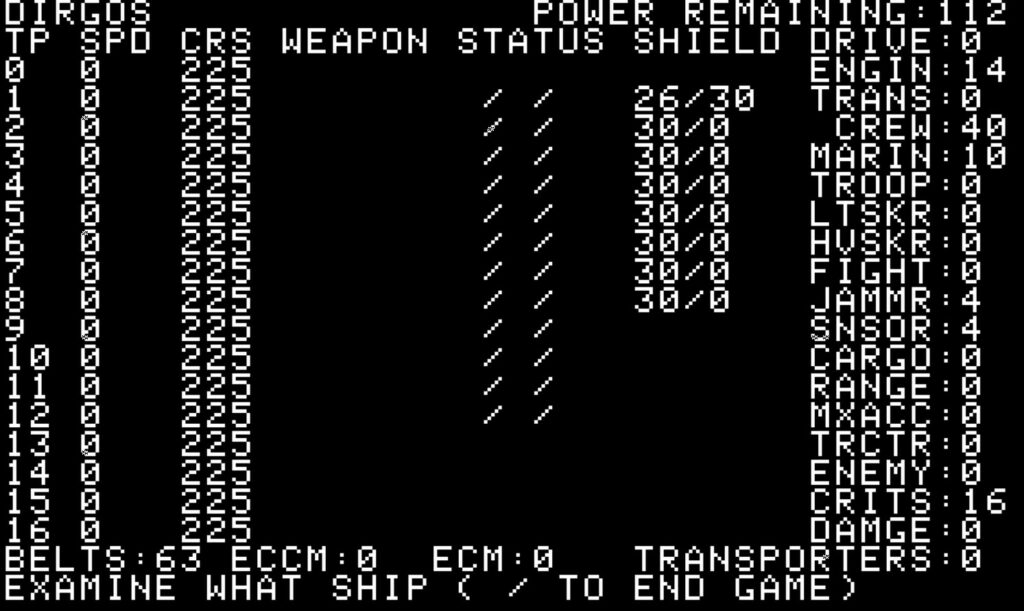
I never pierced its shield, and the planet restored it every turn with its massive power output. I thought 4 siege phasers would be enough, but it wasn’t. I also sent seekers, but they were all intercepted by the massive belt. I should have brought photon torpedoes to destroy the shields, and only then use my siege phasers.
Well, the Hornet got two destroyers, so there’s that.
Rating and Review
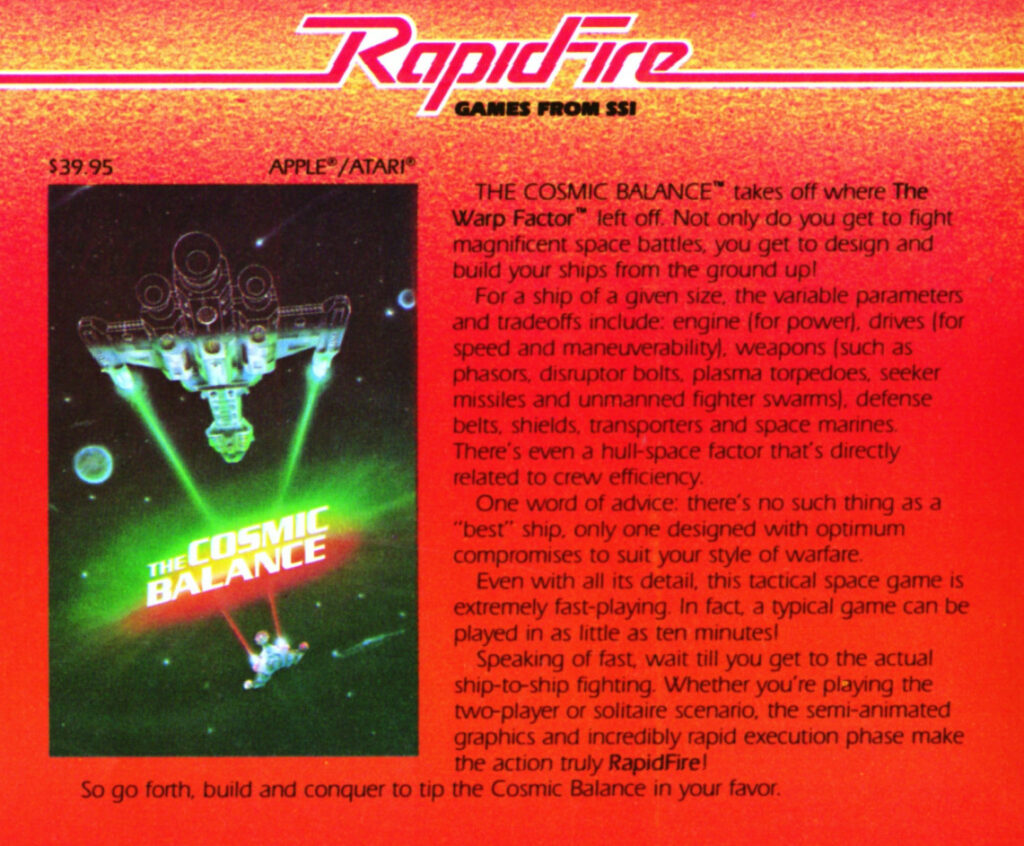
The Cosmic Balance by Paul Murray, published by SSI
First release : September 1982 on Apple II
Tested on : AppleWin emulator
Total Hours Tested : 3 hours
Average duration of a battle: 20 minutes
Complexity : Average (2/5)
Would recommend to a modern player : No
Would recommend to a designer : No
Final Rating: Well designed, but obsolete
No one involved remembers why it was not called the Warp Factor II but the Cosmic Balance was certainly branded as the spiritual successor of Murray’s first game. Yet, despite the numerous similarities, the Cosmic Balance uses a brand new engine : just like Keating had rewritten his engine and transitioned from BASIC to Assembler when moving from Operation Apocalypse to Southern Command, Murray transitioned from BASIC to Assembler between the Warp Factor and Cosmic Balance. Once again, Chris Crawford had been right when he had predicted that programmers of commercial games would either have to transition from BASIC to Assembler, or disappear.
The removal of loading speed, and some game design changes, massively curtailed the time needed to play a battle. Even on an emulator, a small-size battle would last one hour or more in the Warp Factor, maybe 20 minutes in the Cosmic Balance. This allowed the game to be part of the RapidFire line of products that I described in my CYTRON Masters article.
The game was priced at the lower SSI price point : $39.95, just like the Warp Factor. The content in the box was minimal : the game disk, the manual, not even one reference card. Initially released on Apple II, it was shortly thereafter released on Atari, and a bit later on Commodore 64 – but never on IBM PC.
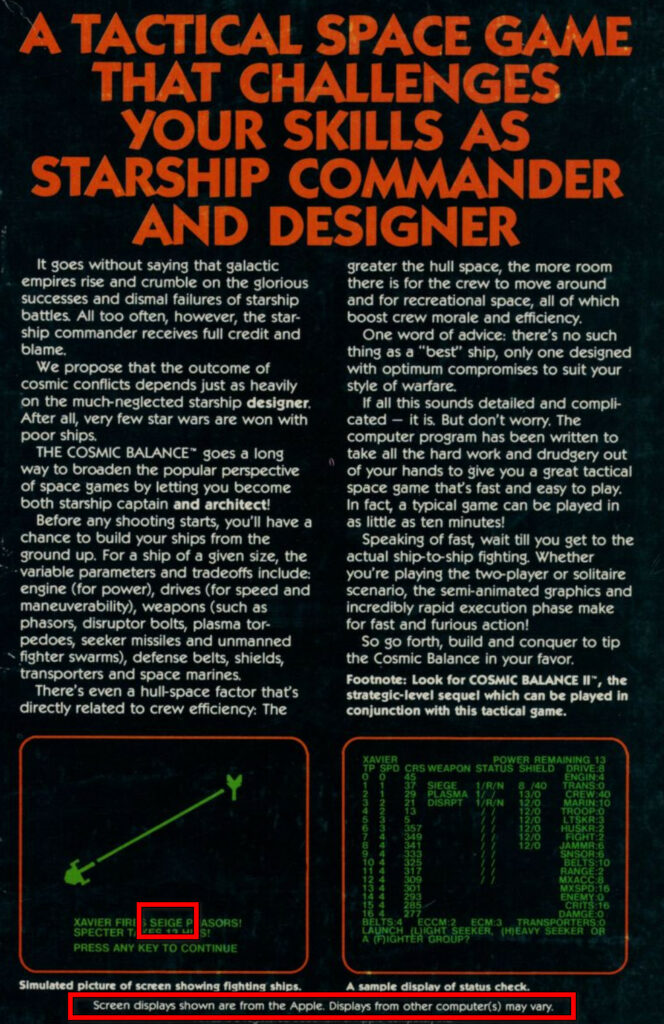
And now, to the review :
A. Immersion
The Cosmic Balance tried very hard to toss aside all references to Star Trek, though I would say it did not quite succeed, with the first tutorialish battle between a ship called “the Enterprise” and another called “the Reliant”, which Trekkies will recognize.
Apart from that, there is not much to feed on : there is only one art asset for each side, the story is fully contained in one page and in the scenario description :
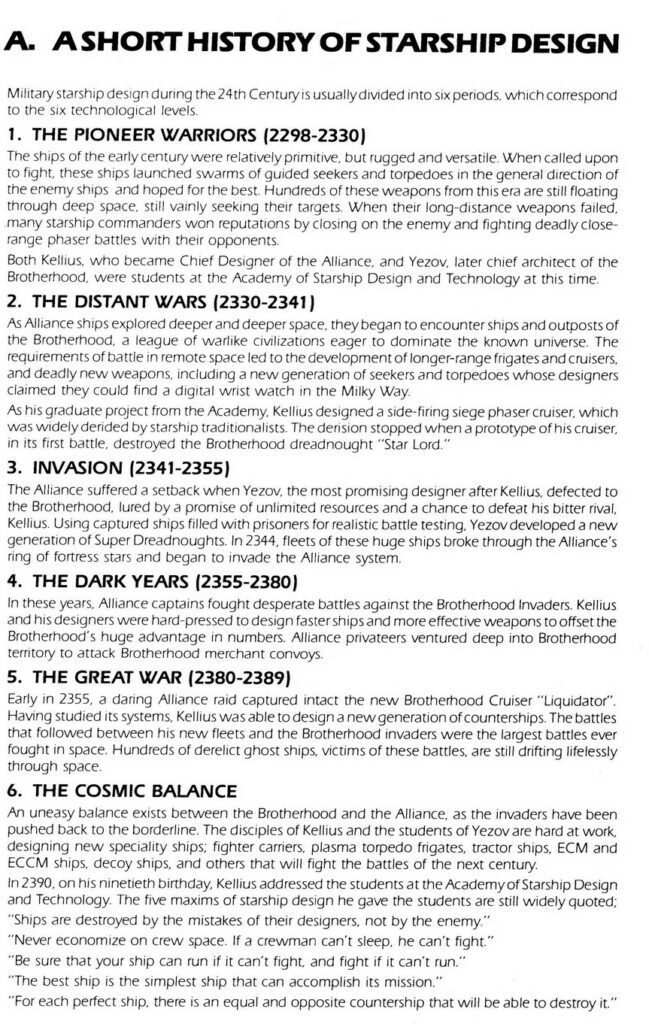
So immersion will be what you put into the game, trying to replicate your favourite ships from sci-fi series, movies or books, or even comics – I won’t judge. And there, I have to say the number of options is astronomical, but more on this later.
Rating : Poor
B. UI , Clarity of rules and outcomes
The UI is miles ahead of the Warp Factor. Instead of answering up to 16 questions in a row, you can give specific orders each turn, change your order freely, check the situation of the other ships, check where your ships will be in the middle of the next turn, etc…

Similarly, turn resolution in the original Warp Factor was a wall of text, so you had to interpret what happened. In the Cosmic Balance, you see the ships moving, so don’t have to guess why your ship did not shoot at its designated target ; this feature was actually added on the IBM PC version of the Warp Factor.
The game is not perfect though: it is obviously not visual at all, the only way to see which system is damaged is to remember how the system is supposed to be when not damaged. There are still bits of information missing (how much a swarm of fighters is depleted, which shield you hit exactly when you are attacking from an angle just between two shields), but nothing tragic.
Rating : Quite good
C. Systems
There are two systems : the ship-building system and the combat system.
- Combat system
Let’s start with the combat part, and compare it with the Warp Factor. As I said, the game is much faster, first because the Cosmic Balance removed some gameplay features that made some Warp Factor battles so long, for instance the reinforcements of shields, but also the cloak, which made Reman ships incredibly hard to hit.
In addition, there is a turn limitation in most scenarios, and an option to jump out (retreat) if a ship is too crippled to continue fighting ; using the tractor bay you can even either prevent or help another ship to jump.

The weapons are also more specialized, some of them being specifically anti-shield for instance.

The Cosmic Balance also adds the ultimate weapon : the fighter bay. A fighter only deals one damage… but they are 30 of them in a swarm, and they can only be shot down by belt defences. Given belt defences also stops plasma torpedoes and seekers, they are an absolute must-have.

Overall, the new balancing gives a lot more tactical options and a rock/paper/scissors meta.
- shields are countered by torpedoes/seekers,
- torpedoes and seekers are countered by belt defense and ECM,
- belt defence and ECM are totally useless against phasers,
- phasers have trouble piercing shields,
There are other strategies of course (long-range disruptor attacks, marines), but the strongest alternative seems to be the fighter swarm spam : if you send one of these and your opponent does not have strong belt defences then you just pressed the “I win” button.
My biggest regret is the lack of interaction between allied ships ; for instance, two ships next to each other cannot support each other with their belt defence. This limits the fleet-building options, like designating ships as escorts. The “fighter” system is barebone (send them, and they will kill their target and never come back), so cannot roleplay Admiral Ackbar during the battle of Endor.
2. The shipbuilding part
That’s the new part, but then I covered most of it in the AAR. I appreciate the “technology level” feature : in theory its only significant impact is the space available, but less space forces you to have crude ships that do only one thing well – and even then not that well, so it forces you to take even more difficult decisions than with high-tech ships.
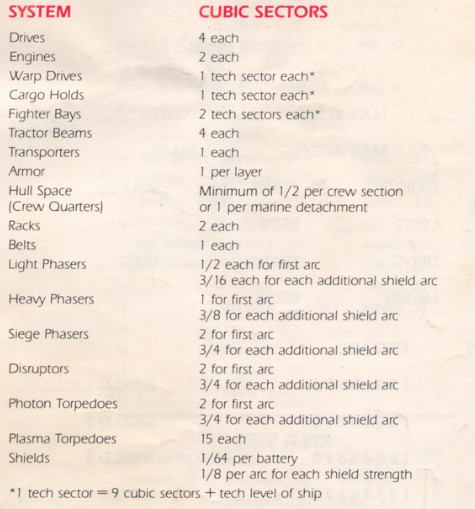
Building ships is really easy, my only nitpick is that the game does not tell you how much power your ship needs each turn to use all its drives/weapons/belts/ECM/ECCM ; you will have either to calculate yourself or test in a fake turn and try again.
Rating : Good
D. Scenario design & Balancing
The game proposes 6 scenarios :
- A battle between the Enterprise and the Reliant,
- An attack on a planet (the one I played),
- An attack on a transport ship,
- A “landing” attack/defense (basically, marines in transport ships must survive),
- Two different “general combat” scenarios,
The problem I had in all those scenarios, and I realize I’m being subjective, is that you must design ships for both you and the AI. This takes some time to set-up, but also gave me other issues that really killed my enjoyment :
- Given the combat system has a lot of counters, it is hard to build AI ships “blindly” – somehow you are probably already determining the winner in the way you build the AI ships,
- Worse, if you win a battle, you won’t know whether it is because you gave the AI a shoddy ship (or a ship it does not know how to use) or because you were good,
Again, this is very personal, contemporary reviewers seem to have loved designing the AI ships, but I really hated it. I don’t like designing ships in a vacuum and any victory leaves me with a nagging doubt that it was not deserved since I gave the AI the tools it was defeated with.
Rating : Very poor, but again, mostly because I really don’t enjoy designing AI ships,
E. Did I make interesting decisions ?
Yes during battles, though not with the kind of battles you saw in my AAR (its focus was to showcase the new toys).
As for the design part, well, it felt more like a necessity, so I have ships to play with and ships to fight.
F. Final rating
Well-designed but obsolete – any rating is subjective but I feel like this one is particularly so, as my reluctance to design for the AI is probably very personal.
In multiplayer with someone you play against regularly, I am pretty it was one of the best games on the market, as I suppose that every new battle you would try to bring a better, improved ship to counter your opponent’s latest doctrine.
Contemporary Reviews
The Cosmic Balance immediately divided reviewers : those who loved everything about the game, and those who loved the design part of the game only.
Most reviews belong to the first category. Softalk allocates a long article to it in November 1982. The reviewer immediately compares the game (very favourably) to the Warp Factor. The Warp Factor, you see, was “among the best of the space battle games for the Apple II”, but it was “painfully slow“. The new game solves, and now it is pretty much perfection.
Chris Smith, reviewing all RapidFire games in January 1983 for the Space Gamer, by contrast, was unimpressed by the combat part of the game (“I have seen enough of this type of game”) but enjoyed the ship design part : “The shipbuilding is the main point of the game for me. The battlefield is simply a test bench that tells you what you need to improve your design.”
The Cosmic Balance is also one of those games with which Computer Gaming World had a special relationship. This is perhaps explained by David Long’s intro to his review of the game (January 1983) : “When I bought my Apple two years ago, the very first game I bought for it was Paul Murray’s WARP FACTOR“. In any case, Long’s emphasizes how fast the game is, but also how more immersive it feels, for instance on the behaviour of the shields “Shields, too, are more realistic in Cosmic Balance than they were in Warp Factor. All true outer space battle fans can envision a strained voice in a deep Scottish brogue complaining, “Captain, the shields are buckling, one more blast like that and they’ll blow!!” Well, now the shield will buckle, and you’ll suffer damage (perhaps), but you’ll still be able to reinforce them, and even drain other shields for power, until all your shield batteries are destroyed” In conclusion : “the shipyard. options and the number of scenarios available will keep this one out and in use for a long time.“
Two months later, in March, Floyd Matthews pens an article called “Cosmic Balance : Tactics and Ship Design”. The intro is direct : “Cosmic Balance is possibly the best tactical space wargame available today.” The tactical advice is sometimes good, sometimes less so, but the article is accompanied by a ship design competition :

There were 25 entries that had to fight against ships designed by the judges. Maybe the judges shared my reluctance with designing for the AI after all, and found a way to have ships designed and delivered by mail to them. Confirming my impression on the fighter bays, a large part of the submissions competed to cram as many fighter bays as possible in the 250 victory points worth of ships allowed. In vain, the winner’s design “concentrated on forward-firing weapons and speed. The ship would accelerate at high speed towards a target while firing forward, and constantly keeping its nose pointed at the enemy.” The best ships, including the winning ship and the judges’ ships, were then sold as a data disk.

The contest was so successful that another one was run in October 1984. The game was clearly still very popular, as the number of submissions grew to 37 and the judges also noted that the ships were better than in the first iteration. But there was no second “Shipyard Data Disk” to buy so I assume the first data disk did not sell that well.
On the other hand, with 13 055 copies sold, the Cosmic Balance itself was a total success that remained in the catalogue until Spring 1987. It also once again showed SSI that Joel Billings’ (and mine) favourite genre – historical wargames – was not what the market was asking for. The way was open for Cosmic Balance II, the strategic game that would generate scenarios for the Cosmic Balance.
One Comment
> Redoutable, the Inflexible and the Foudroyant.
I see what you did there 🙂